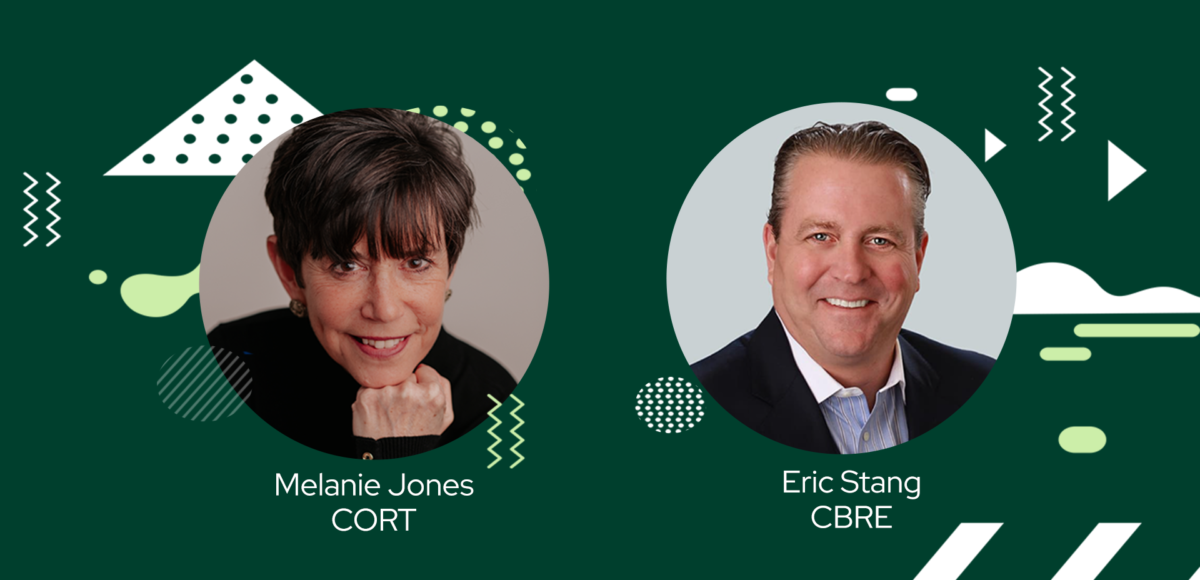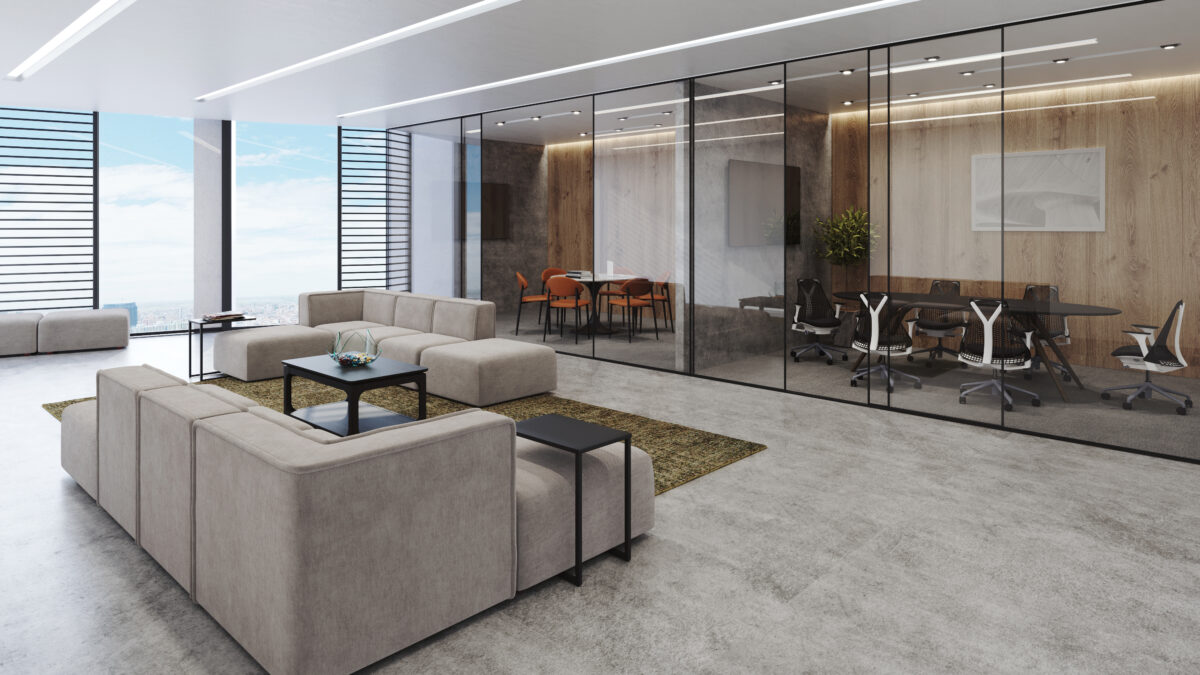At CORT, we operate in an environment of change. Our clients are typically moving, expanding, customizing environments, dealing with unknowns, or transitioning in one way or another. When I met Eric Stang, CBRE’s Senior Managing Director of BTMM, I was anxious to pick his brain. I thought others might be curious about how move management services have evolved over the past few years, how CBRE provides the easy button to customers, and information on increasing sustainability in the workplace.
Melanie Jones: Let’s start with the obvious question. What is BTMM at CBRE?
Eric Stang: BTMM stands for Business Transition & Move Management, and we’re a team of 40+ in the US and Canada who specialize in orchestrating large-scale move and decommissioning projects across all sectors. Decommissioning means providing significant cost savings to clients while mitigating risks and the environmental impact of a move or site closure. We began by managing significant headquarters relocation projects and continued to evolve into life sciences, industrial, higher education, and K12.
We are a unique group, no doubt about that. Our expertise is highly specialized. We have talented project management teams at CBRE but our team steps in when the client needs support beyond a simple move.
Our team members must be able to present at a town hall with 300 or 400 people, contribute during an executive meeting, and provide detailed updates on the overall relocation scope, and still find themselves on a loading dock at 2 am occasionally. We’re careful who we bring on to this team.
I was with a small Midwest consulting move firm before CBRE acquired us in 2006. We have other people on our team we brought over as well. Our people, their passion, and their expertise and experience are the cornerstone of why we’ve been so successful.
As far as services go, we have a very structured process focused on moves but, more importantly, all the planning that goes into a move. So much of our work has nothing to do with trucks and boxes. It’s about the end-user experience. It’s about how do we make each and every end-user remain productive throughout the process.
What does “Day One” look like when they arrive at a great new space? Our clients spend a lot of time, effort, and money to create a new space. The last thing any real estate organization wants is for its end-users to have a negative impression of the move…and, ultimately, the project. This is the one touchpoint on the project that involves each and every person in the organization.
Melanie Jones: It sounds like the old Stephen Covey quote, “Begin with the end in mind.” That’s what you must do.
Eric Stang: Absolutely. We have a process and know what needs to happen to create and execute the correct plan with the proper logistics. As such, our service offerings have expanded.
For example, we always offered decommissioning services, primarily because we were the last ones standing on a project. Many clients would wait too long and realize they had much to do before the transition was complete. It’s easy to focus on the shiny new penny, getting everyone and everything in the new place. Then, the oh-no moment of exiting the old space.
Our job is to think these types of things through on the front end and ensure our client is prepared to turn the space back to the landlord the way they need to.
We created a process around mitigating the risk associated with that decommissioning and ensuring that we negotiate with the landlord very early in the process. We engage our brokers as well to help us with that the negotiations. They have very deep relationships with landlords. So, we’re working every angle to decommission the space and provide the best possible value to our clients.
We evaluate and negotiate constantly. How much can our client leave behind? Can we leave low voltage in place? Can we leave certain appliances, how about furniture? Everything costs money to remove. We have a great network of almost 500 partners, and we drive some value, but decommissioning is not cheap at the end of the day. It’s very labor intensive, and furniture does not retain value well.
Melanie Jones: Surprisingly, many clients expect value from a product that’s just a few years old, and it’s simply not there. I believe that is one reason CORT’s Furniture-as-a-Service™ model is being adopted by our clients more often.
In many cases, an expensive furniture purchase is not the only option available, especially when the future isn’t 100% clear. We have a Total Cost of Ownership calculator to help clients make evaluations.
Eric Stang:
I agree. Often, clients think furniture should be worth half the value because they invested $5,000 a seat for furniture three years ago. No, it’s not. Those are the tough conversations we must have. Everything costs money, and at the end of the day, we are still facing labor challenges on top of everything else.
Melanie Jones: Let’s switch over and talk about sustainability. The benefits you’re bringing to your customers in decommissioning services are related to forward progress in sustainability.
Eric Stang: There are two pieces. First, the simple things like using reusable plastic totes rather than corrugated boxes. Having an efficient plan is also crucial.
On the decommissioning side, it’s a combination of our vendor network and the experience of our team. We have one of the largest networks in this business to repurpose and sell products, whether task seating, panels, generators, raised flooring, or electrical switchgear.
For example, we’re selling a lot of generators resulting from supply chain issues. We have clients looking for generators who can’t get them based on the lead time. So, we can make some marriages between folks selling items and needing them, thanks to our network.
We also have many options for disposing of items. As last resort, but when needed, we try and use EPA-certified clean-burn processes in certain markets. Products can be burnt to a powder, which keeps a large volume of items out of a landfill. These are things clients are asking us about more than ever.
Melanie Jones: Let’s talk about the extensive move management playbook you authored. Why did you write it, and what’s the value to your team and customers from it?
Eric Stang: It’s a collection of our processes that has evolved over 25 years. We started documenting best practices for our team to make sure they understood the methodology needed from the project kickoff to the first day in the new space. The playbook allows our team to pull one of 75+ deliverables “off the shelf,” and project managers can customize it based on client requirements. The goal of the playbook is to never start with a blank sheet of paper! All of this has been key to many of our successes.
We aren’t Furniture-as-a-Service experts, we’re not record management experts, and we’re not telecom experts, but we are experts at integrating all the parts. Orchestra leaders, if you will. It all ties back to the end-user experience. That’s why we created the process.
Melanie Jones: Certainly, your team must stay open-minded to new ways of doing things! Example CORT’s Furniture-as-a-Service model. Understanding how access to the furniture instead of ownership can benefit a client and knowing when it’s the suitable recommendation to your client. And so many other things, right? You must always stay tapped into current trends.
Eric Stang: Absolutely, that’s our goal. And even down to deliverables have changed. We used to manage our post-move process primarily on-site in a conference room. We still lean on our systematic procedures for taking those requests and dispatching the right resource, but it’s different. It’s a different world we’re living in, so we had to adapt some of these processes to leverage technology and expand vendor partners to support new needs.
Furniture-as-a-Service is a terrific example. Flexibility is more important than ever, so making a recommendation to rent furniture instead of owning it is a new tool we can bring to the table.
Melanie Jones: Overall, what are you seeing regarding customers’ real estate needs? Are they downsizing at all?
Eric Stang: Yes, many of the clients we work with are downsizing. An example would be reducing space from five floors to three and creating a restack. Perhaps three floors are reconfigured, and two go through decommissioning. Clients are starting to make decisions and move forward. Much of the change is adding flexibility. There’s a trend to have less square footage but better space: different amenities and more robust technology. Anything to help employees be more productive and effective.
Melanie Jones: As you know, CORT has a product called 4SITE, a sensor technology solution to collect and measure occupancy. It’s helping our clients measure and monitor utilization data related to what employees use areas of space and furniture. The data helps real estate leaders make solid decisions regarding the workplace and real estate footprint. I agree we expect to see more activity, movement, and decisions come faster.
Eric Stang: That’s valuable! Indeed, after the 1st of the year, we anticipate more folks returning to work. Change is good for both our businesses. The challenge during Covid was everybody sitting on their hands and just waiting.
Melanie Jones: If you had a crystal ball, what do you see on the horizon for CBRE?
Eric Stang: I think we are positioned very well as an organization, both financially and in service delivery. We can now perform projects for our clients as a one-stop-shop, turnkey solution. From a transaction to interior design and engineering, build-out through move and decommissioning, CBRE can do all of this work in Principal. Clients continue to navigate their own internal real estate needs and what they’re doing with their staffing. More and more clients come to us for advice and are curious about the cost of integrating the different offerings we can provide.
We offer Office Ready, a fantastic tool where clients can quickly learn how they want their space to look, color palettes, furniture options, etc. It’s a way for a company to quickly get moved into a new space without hiring separate firms for each service required to complete a project.
Melanie Jones: Part one of this Workplace Talk was with Brian Jarrett, Managing Director of Project Management for CBRE in the Texas area. We discussed CBRE’s push towards offering the Principal Product Group concept. Do you anticipate growth in this area?
Eric Stang: Absolutely, it’s an excellent service that we’re doubling down on as an organization. It becomes the “easy button” for the client.
It’s a single contract. I’ve invested a lot of time and effort in building the infrastructure for my team to be able to assume responsibility for our work. Other groups have done the same. The client might choose to manage part of a project and have CBRE own the rest. I look at it like this, they have a business run, and we have a business to run. Let us handle the part of the business where we excel and are the experts.
We can be transparent, but at the same time, clients want to know we own the risk and responsibility, but they will receive the necessary reporting. In our decommissioning world, that might be here’s what we’ve done from an environmental standpoint, what was recycled, what was sold, what was donated, etc.
Melanie Jones: That’s phenomenal and aligns nicely with a world that is more and more service-oriented every day. What challenges do you see ahead? What are some of the roadblocks?
Eric Stang: That’s a great question. I think for us, resources continue to be tough. We still have a tight labor pool, which significantly impacts our service providers.
They have challenges from a resource perspective, and we must have honest conversations with them. We always tell our key partners that it is okay to say no to opportunities. We count on our service providers to stand behind their commitments. This will be the most significant hurdle over the next year or two.
Melanie Jones: So, the last question, what’s your favorite part of your mission? What gets you fired up in the morning?
Eric Stang: I now have a hybrid role of selling our traditional move and decommissioning services and some of these integrated services. Winning recharges my battery. We are not always the lowest price, but we can walk clients through our processes and playbook. It’s rewarding to win based on value. That is a common theme running through CBRE. And certainly fuels my fire. Back when I was involved with delivering projects, it was all about day one and seeing hundreds of employees productive in their new work environment as a result of our process. This employee productivity and our ongoing metric of delivering 90%+ end-user satisfaction scores was and is a testament to our team’s hard work and the long hours it takes to deliver a complex relocation.






